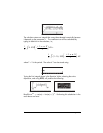
Page 16-31
The result is c
n
= (i⋅n⋅π+2)/(n
2
⋅π
2
).
Putting together the complex Fourier series
Having determined the general expression for c
n
, we can put together a finite
complex Fourier series by using the summation function (Σ) in the calculator as
follows:
Θ First, define a function c(n) representing the general term c
n
in the complex
Fourier series.
Θ Next, define the finite complex Fourier series, F(X,k), where X is the
independent variable and k determines the number of terms to be used.
Ideally we would like to write this finite complex Fourier series as
However, because the function c(n) is not defined for n = 0, we will be
better advised to re-write the expression as
)
2
exp()(),( X
T
ni
nckXF
k
kn
⋅
⋅⋅⋅
⋅=
∑
−=
π
+= 0)0,,( cckXF
)],
2
exp()()
2
exp()([
1
X
T
ni
ncX
T
ni
nc
k
n
⋅
⋅⋅⋅
−⋅−+⋅
⋅⋅⋅
⋅
∑
=
ππ


















